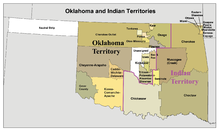Oklahoma Land Run
The Oklahoma Land Run , sometimes also referred to as the Oklahoma Land Rush (freely translated from the English Oklahoma Land Race or Oklahoma Land Race ), led to the settlement of the western half of the last Indian territory (Indian sanctuary) on April 22, 1889 of the USA in the area of what is now the US state Oklahoma by Anglo-American settlers . The future capital of the state, Oklahoma City , was built relatively quickly . The Oklahoma Land Run is considered to be one of the historic cornerstones that symbolically mark the end of the US pioneering era , which is often referred to as the Wild West in today's popular culture .
Historical context
Most of the remaining Indian territory in the Oklahoma region had been primarily tribal to the Five Civilized Nations , the Cherokee , Chickasaw , Choctaw , Muskogee and Seminole tribes . These tribes were to 1838/39 the Trail of Tears (English. Trail of Tears ) forcibly removed from their ancestral homeland (of various more eastern US states) in the as inhospitable applicable Oklahoma Territory forcibly relocated been, where it is the country with local tribes had to share.
In 1880 the US government banned European colonists from settling in the area. Nevertheless, settlers crossed borders again and again, to which the authorities did not counter any noteworthy consequences. In order to legalize further settlements, negotiations with the Muskogee and Seminoles began in 1885, which ultimately led to the release of around 2 million acres (≈ 8,094 km²) of land in 1889 .
The Oklahoma Land Run was the result of the corresponding signing of a proclamation by US President Benjamin Harrison on March 23, 1889 (barely three weeks after his inauguration), according to which non-indigenous settlers were allowed to settle part of the Indian territories. This statement took effect one month later, on April 22nd. In the days before, some colonists had illegally crossed the border to the Cherokee Outlet (a western tip of the Cherokee area) and secretly staked out land parcels ( claims ) for themselves. After these "Sooners", the early land occupants (from English soon , "early"), the later US state of Oklahoma, located in the southernmost part of the Midwest of the USA, received its nickname The Sooner State .
On the morning of April 22, thousands of the new settlers gathered on the border of the Cherokee outlet . After the starting shot at 12 noon, the race of these colonists began for the best possible piece of land in this area.
Oklahoma was organized as US territory in 1890 , and the settlement area continued to expand until 1906, before Oklahoma joined the United States on November 16, 1907 together with the remaining Indian territory as the 46th state .
The Oklahoma Land Run in Film and Literature
Above all, the settlers' hunting ground after the start was a template for action-packed scenes:
- Pioneers of the wild west (original title: Cimarron ); USA 1931, directed by Wesley Ruggles , leading actors: Richard Dix , Irene Dunne , based on a novel by Edna Ferber , romantic western , history of the Oklahoma territory as part of a romance and family history from the perspective of an Anglo-American adventurer
- Oklahoma Kid (Original title: The Oklahoma Kid ); USA 1939, directed by Lloyd Bacon , leading actors: James Cagney , Humphrey Bogart , fictional story about a young man who avenges his innocent hanged father against the backdrop of the Land Run.
- Cimarron (Original title: Cimarron ); USA 1960, directed by Anthony Mann , leading actors: Glenn Ford , Maria Schell , remake of the 1931 version in color and cinemascope .
- In a distant land (Original title: Far and away ); USA 1992, directed by Ron Howard , leading actors: Tom Cruise , Nicole Kidman (fictional story of two immigrants of Irish origin who ultimately find their new home at the Oklahoma Land Run).
The Belgian comic artist Morris had his legendary hero character Lucky Luke appear as a leading figure in the settlement of Oklahoma and the Land Run in the volume Auf nach Oklahoma .
Web links
- The Rush to Oklahoma ; contemporary article from May 18, 1889 from Harper's Weekly by William Willard Howard
- Oklahoma Land Openings 1889-1907, chronological overview of the land acquisition of Oklahoma with additional links e.g. B. Regarding the affected Indian peoples (English)

